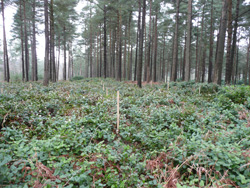Summary
Summary

Salal (Gaultheria shallon), often referred to as gaultheria, is a vigorous, evergreen perennial shrub that is becoming an increasing problem in lowland forests across the UK. Once established it is extremely difficult to control, and if left unchecked it makes tree regeneration impossible. This project therefore aimed to find a way of controlling Gaultheria shallon.
Research objectives
- Review existing non-chemical and chemical methods of managing Gaultheria shallon.
- Identify a suitable herbicide regime for controlling Gaultheria shallon.
Results
Encouragingly, we found that a single application of 2.69 kg a.i. ha-1 picloram (as 11.2 litres ha-1 Tordon 22K ® (240 g l-1 picloram)) diluted in water plus the adjuvant Mixture B NF® at 2% of final spray volume, applied between spring and mid-summer, killed all treated plants within two growing seasons. In addition we found that treatment with 3.84 kg a.i. ha -1 triclopyr (as 8 litres ha-1 Timbrel® (480 g l-1 triclopyr)) diluted in water plus Mixture B NF ® at 2% of final spray volume, sprayed initially when flower buds are swelling or flushed, but vegetative buds are largely dormant (late April in southern England), with a repeat application made 4-8 weeks later, was also very effective. However, unfortunately, since setting up the trial, suitable triclopyr or picloram products are now no longer available for use in the UK.
The next most effective herbicide treatment in our work, and the most effective currently available, was an application of 3.6 kg a.i. ha -1 glyphosate (for example as 10 litres ha-1 Roundup ProActive® (360 g l-1 glyphosate)) diluted in water plus Mixture B NF® at 2% of final spray volume, applied initially when flower buds were swelling or flushed, but vegetative buds were largely dormant (late April in southern England), with a repeat application made 4-8 weeks later (May – June), followed by a repeat of this treatment programme the following year (i.e. four sprays in total).
Crucially, our work suggested that the default herbicide treatment that many managers may be tempted to try if they are faced with eradicating gaultheria, which is often a single application of glyphosate made during the summer, is likely to be completely ineffective, even if a high dose rate is used.
Whatever herbicide programme is used, even if involves spraying over two years as we would recommend for glyphosate, some follow-up treatment will be needed once the initial sequence of applications have taken place, and silvicultural practices that discourage future re-infestation will be required.
Resources
Full details of this research are contained in the following scientific paper:-
Willoughby, I.H., Forster, J. and Stokes, V.J. (2017 in press) Gaultheria shallon can be effectively controlled by the herbicides picloram, triclopyr or glyphosate if they are applied at the correct time of year. New Forests, in press. DOI 10.1007/s11056-017-9615-3.
A full text version of this paper is available to view for free
Status
This project started in 2013 and is now complete.
Contact
Funders and partners
This research was funded by Forest Enterprise England. In addition, the Forestry Commission funded the production of the scientific paper via the Delivering Resilient Forests research programme of the Forestry Commission Science and Innovation Strategy
Forestry Commission policy
This research will help managers deliver sustainable management and the protection of the forest resource against biotic threats across the UK as outlined in the UK Forest Standard. It will also help deliver Forestry Commission England, Scottish Forestry, and Welsh Government polices to reduce the impact of invasive pest species.
